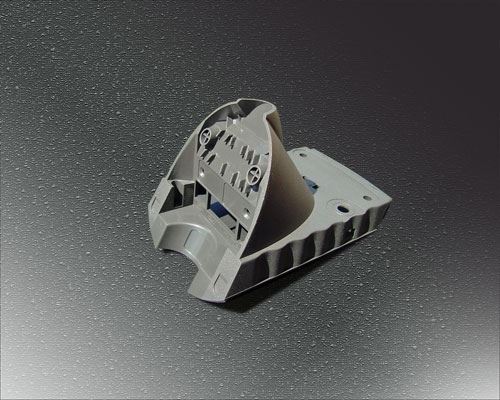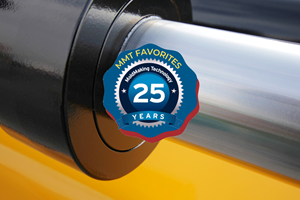Mold Quoting Software Gives Moldmaker an Edge in Winning Jobs
During its 39 years in business, Quashnick Tool Corp. (QTC; Lodi, CA) has made a name for itself in Silicon Valley and the Greater Bay area by building complex injection molds to very high tolerances for a variety of industries—including medical and electronics.
During its 39 years in business, Quashnick Tool Corp. (QTC; Lodi, CA) has made a name for itself in Silicon Valley and the Greater Bay area by building complex injection molds to very high tolerances for a variety of industries—including medical and electronics. As delivery times have tightened and competition is on the rise, the company has been tasked with the challenge of producing mold and part pricing information almost immediately for its customers. Fortunately, mold and part quoting software from Comber, ON-based JDL Technical Services’ Perfect CalCard software fits the bill.
Along with the medical and telecommunications industries, the electronics industry has been an important factor in QTC’s foundation and growth, notes QTC Engineering and Tooling Business Manager Derek Beattie. “We have established ourselves as a top-quality mold manufacturer by building molds for historically-important companies involved in the electronics industry—such as Atari, Raychem, Tyco, AISIN, Plantronics, Apple, Sun Microsystems and HP. Currently, molded parts for electronics comprise a significant portion of our annual sales and we are actively marketing to this industry in order to widen our customer base,” he states. “We specialize in smaller tooling and molding for various connectors, circuit board components, switches, cases and housings.”
Beattie explains that it was becoming more of a challenge for the company to quote quickly and accurately. “Customers are condensing development cycles on very complex programs,” he affirms. “They need to have mold and part pricing information as early as possible to aid in design-to-cost considerations, and for budgeting and scheduling decision."
The Cutting Edge
QTC maintains very high accuracy and tight tolerances on its production tooling, Beattie maintains. “Plastic part feature tolerances are often in the ±.001-inch range and through rigorous molding process optimization and use of SPC we are able to consistently hold tolerances” he says. “Surface finishes range from EDM to Mold-Tech-type (mold-tech.com) texturing to lens quality diamond polish and anywhere in-between.”
To quote these cutting-edge molds, Beattie had been using Excel spreadsheets with internally developed formulas to determine mold build, modification and molded part pricing for years. “This method works fine if you are only quoting one mold or one molded part every week or so,” Beattie points out. “However, even with smaller quoting requirements there are still some challenges that need to be addressed in order to be efficient and consistent in quoting. These are: no integrated materials database with steel and resin data and pricing; no integrated machine database with capabilities and rate specs; no direct plastic part feature analysis and link to quote; difficult to compare quotes quickly; subject to error both in formula entry as well as lack of overall project considerations; extremely cumbersome and difficult to adjust across multiple spreadsheets; and a need to address molded part pricing at various production quantities.”
Beattie can recall the specific job that led him to seek out a better method. “We routinely see RFQs for multiple mold projects; and in 2009 we had one in particular that really exposed the inadequacy of our old Excel spreadsheet quoting routine,” he states. “A young medical device manufacturing company with a new product contacted us and we began working on quotes. Over a period of about three to four months we consulted on and quoted 24 different molds in several different configurations—including molded part pricing—relating to the molding configuration (number of cavities) in a range of production quantities. Needless to say, I began the typical development of multiple spreadsheets, adjusting formulas, researching moldmaking material and resin pricing and trying to tie it all together into a comprehensive package with related and comparable data across the board.”
During this process, Beattie couldn’t help but think there had to be another way to proceed. “I wanted to be able to research resin pricing, enter it into a database and have access to it every time I quoted a similar part,” he states. “I needed a system that would help me quickly analyze the molded part solid model for wall thickness, parting lines, undercuts, weight determined by volume and selected resin specs, bosses, etc., quickly and efficiently—and then would allow me to import that data for use as I quote. The package had to allow me to quote molded parts at varying cavitations with different secondary operations, inspection, packaging, etc. requirements and have the ability to generate comprehensive reports with pricing at several production quantity levels.
“This is especially important in low quantity production runs where small changes in the quote can affect the part pricing significantly,” Beattie continues. “Missing these details when quoting short-run production can really cost you—both in lost profits as well as in delivering to every customer expectation. We needed a software package that would reduce the time necessary to generate quotes, while increasing their accuracy and consistency in a way that was both fair to our customers and beneficial to our company.”
Supportive Software
Beattie found what he was looking for with Perfect CalCard. JDL Technical Services President Jeff Lambing explains that his software gives an automatic calculation of both mold and part costs with the following features:
- Calculation of plastic injection molds, pressure die-casting molds and stamping tools
- Automatic calculation of part costs
- Quick and easy estimating (enter part geometry => select mold type => get tool cost)
- The ability of 3-D data to be imported (optional)
- Different degrees of detail possible (from rough calculation for beginners to detailed calculation for mold experts)
- Input of minimal geometry data to obtain quote
- Definition of mold profiles or templates for different product groups—eliminates all tedious manual entries
Beattie notes that the standardized database has saved him time. “I can input the same information—plastic materials for example—and once the pricing and processing information is there, I don’t have to look it up,” he explains. “Because it is already in the database, it is easy to select what is needed for each job. There is also an area for notes specific to each material, and I use this to note the date that pricing data was input as well as the resource used. That way I can quickly check pricing if there has been a significant amount of time between quotes.”
“An optional part of the package that I highly recommend is the Magics 3-D model analysis software,” Beattie adds. “Magics works directly with CalCard and allows you to quickly analyze the model for all of the things a moldmaker would want to know before quoting a job. In just moments, the user can orient the part to the mold, check for undercuts and draft, measure wall thickness, and even generate a basic cavity and core block based on the pull direction and parting line. Once you have finished the analysis, you can automatically export that data back into CalCard—where the surface area, volume, weight based on material density, undercuts, etc. are recorded automatically for use in your mold and production price quotes.”
It is important that the person using the software have a working knowledge of the industry and the basics of mold quoting, Beattie maintains. He urges potential users to familiarize themselves with the software before using it. “Establish your own labor and machine rates. Use your experience and take time to understand how to best apply this tool to your business. Because CalCard is so flexible and customizable, it will take some time investment up-front to determine your actual costs and then translate them into the software. But, it is well worth the effort!”
Perhaps most important is the fact that CalCard has kept Quashnick more competitive in a global market. “This software has left us with a better understanding of what our true costs are to run machines, build molds and ultimately injection mold the plastic parts,” he notes. “It has made us more efficient.”
Related Content
Making Quick and Easy Kaizen Work for Your Shop
Within each person is unlimited creative potential to improve shop operations.
Read MoreExploring ISO 9000 - Part 16 Control of Quality Records
A Series of International Standards for Quality Management and Quality Assurance. We begin 2022 with a review of Clause 4.16 Control of Quality Records.
Read MoreHow to Correctly Size a Hydraulic Cylinder
This week Randy shares steps for correctly sizing a hydraulic cylinder on a mold.
Read MoreRevisiting Some Hot Runner Fundamentals
What exactly does a hot runner do? If you’ve been in the injection molding industry for any length of time, you might think the answer is obvious, but it is not.
Read MoreRead Next
How to Use Strategic Planning Tools, Data to Manage the Human Side of Business
Q&A with Marion Wells, MMT EAB member and founder of Human Asset Management.
Read MoreAre You a Moldmaker Considering 3D Printing? Consider the 3D Printing Workshop at NPE2024
Presentations will cover 3D printing for mold tooling, material innovation, product development, bridge production and full-scale, high-volume additive manufacturing.
Read MoreReasons to Use Fiber Lasers for Mold Cleaning
Fiber lasers offer a simplicity, speed, control and portability, minimizing mold cleaning risks.
Read More.png;maxWidth=970;quality=90)









.png;maxWidth=300;quality=90)






_300x250 1.png;maxWidth=300;quality=90)





.jpg;maxWidth=300;quality=90)







